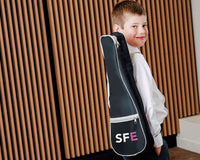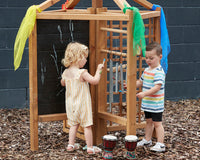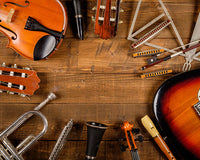If you are starting to learn the drums, or if you’re only a casual player, then you might not quite understand what accessories you need, or why you’d need them. So here’s a quick list of the more common drum accessories, with how or why you’d need them explained!

Sticks
Drum sticks are often categorised into sizes, mostly commonly 5A, 5B and 7A. With this, the number corresponds to the diameter of the stick. With 7 being the thinnest, 5 being somewhere in the middle and 2 being the thickest.
The letter corresponds with the weight of the stick, with A being lighter and B being heavier. Though this is a more traditional way to label drum sticks, some manufacturers will use their own codes and sizing.
The other big thing to know about drum sticks is what material you prefer for the tip. Generally drum sticks will come with either a wood or nylon tip. The reasons for choosing one or the other are generally due to durability. Though the response when using cymbals is affected.
Wood tips are prone to chipping, where Nylon tips don’t have that problem. With Nylon tips there is the chance that the tip can come off after heavy usage. Wood tips also provide a slightly warmer tone on cymbals, where Nylon tips are significantly brighter.
Sticks are available in different materials too, this can often affect weight or durability. Very often sticks will be made of Hickory, but it’s not uncommon to see sticks made of Maple or Oak.
Brands such as Vic Firth, Zildjian and ProMark are very popular. But, if you’re still looking for the stick type that suits you it might be worth looking into cheaper sticks such as the Rocket drum sticks. This lets you try a variety out for less until you know what you like!

Drum Key
A drum key is used for adjusting drum heads, they are vital for changing heads or tuning your drums. They are quite a cheap item, but they’re very useful, and very easily lost.
It’s good to have one with a keyring hole on your keys, as well as one with your kit. It’s one of those items that you don’t want to be without when you need it!
If you don’t know how to tune the drums then I wouldn’t worry too much. Drums aren’t like an instrument such as a violin that needs to be in the correct tuning to sound right. A drum kit is essentially an “untuned percussion” instrument. Though each drum is tuned to ensure the best sound and tension. Along with this, drum tuning can be a very personal thing. Some people tune their toms in fifths, some in fourths and others will have their own methods. Terry Bozzio once toured with 26 toms all tuned chromatically, so there’s a lot of freedom in how you tune your drums!

Drum Throne
A drum throne, or drum stool, can be very important. As much as it’s easy to think of them as just a seat, the design is optimised for playing drums. The rubber feet ensure you won’t slide across a floor, the placement of the legs ensures that it won’t topple over, and the actual seat is made so that you can play comfortably, and can move uninhibited.
Generally a double braced drum throne is preferable to ensure the extra stability, but if you are only practicing at home then it isn’t necessarily as important. Some brands will have extra features within their thrones, such as the Mapex Memory Loc Drum throne, which drives the price up, but allows for additional security and durability.

Practice Pad
A practice pad is fairly self-explanatory. It’s essentially a pad that you can used to practice general exercises and warm-ups. Unlike other instruments, you can’t exactly have a quick practice session while you’re waiting for dinner. Drums require a lot of time for setting up. Unless you’re lucky enough to have the space for a kit to be set up year round! Even then there is the issue of volume. A practice pad allows you to get some practice in without disturbing the neighbours or waking family up. It also helps that they are generally very portable, so you can get practicing while you’re waiting for a bus or warm up before a gig.
Practice pads often come in the form of rubber pads which give you something to hit without causing a lot of noise. But some aim to replicate the feel of an actual drum. Each have their own benefits and drawbacks, but generally they’re much better to use if practicing with your full kit isn’t feasible.

Drum Silencers
Following the practice pads, you can get rubber pads which aim to make your actual drum kit quieter. These are great for practicing without creating too much noise. While they reduce the volume by quite a bit. You still probably won’t get away with practicing blast beats at 3am! But they are a good option if you don’t have anywhere which is relatively sound proof to practice.
These are available for the drums and cymbals of a kit, though hi-hat and cymbal pads are often sold separately.




















